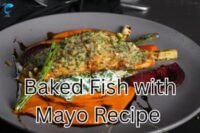Top 10 Fish That Stay at the Top of the Tank (2025)
Published: 2 Jun 2025
An aquarium where fish only swim in the middle or bottom zones can feel incomplete and visually dull. To create a more balanced and engaging tank, it’s essential to include fish that stay at the top of the tank. These active surface swimmers bring life and motion to the upper water column, enhancing the overall look of your setup.
In 2025, many top-dwelling species are gaining popularity for their beauty and compatibility. Here’s your guide to the top 10 surface-dwelling fish that add energy to the top level of any aquarium.
1. Silver Hatchetfish (Gasteropelecus sternicla)
The Silver Hatchetfish is a remarkable top-dweller, characterized by its unique hatchet-shaped body and wing-like pectoral fins. These features allow them to ‘fly’ just below the water’s surface, creating a fascinating spectacle in your aquarium.
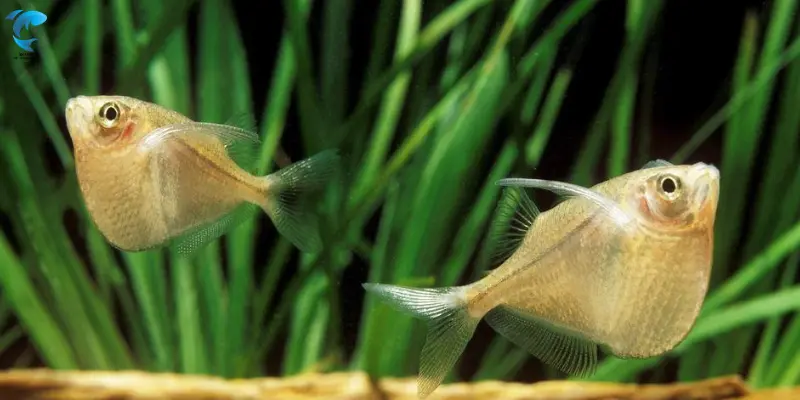
Appearance
They grow to about 1.5-2.5 inches (3.8-6.4 cm) with a silvery body featuring a compressed, deep chest that resembles a hatchet head. Their large pectoral fins extend outward like wings.
Care Requirements
- Tank Size: Minimum 20 gallons for a proper school
- Water Parameters: 75-80°F (24-26°C), pH 6.0-7.5, soft to moderately complex water
- Social Structure: Schooling fish that need groups of at least 6-12 individuals
- Special Considerations: Excellent jumpers that require a tight-fitting lid with no gaps
- Diet: Floating foods, including crushed flakes, freeze-dried daphnia, and small insects
Why They’re Great: The Silver Hatchetfish creates a mesmerizing display with their unique ability to ‘surf’ along the water’s surface. Their popularity has surged in 2025, thanks to improved captive breeding programs, making them more readily available and hardier than their wild-caught counterparts.
2. Marbled Hatchetfish (Carnegiella strigata)
The Marbled Hatchetfish is another spectacular surface swimmer, distinguished by its beautiful marbled pattern.
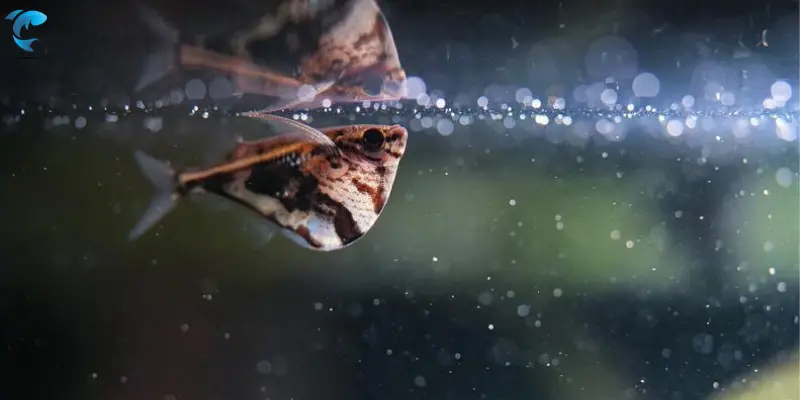
Appearance
Slightly smaller than their silver cousins at 1.2-1.5 inches (3-3.8 cm), they display an attractive marbled pattern of dark bands against a silvery background.
Care Requirements
- Tank Size: Minimum 15-20 gallons
- Water Parameters: 75-82°F (24-28°C), pH 6.0-6.5, prefers soft, slightly acidic water
- Social Structure: Keep in schools of at least 6
- Special Considerations: Requires soft, acidic water and a secure lid
- Diet: Small live or frozen foods like fruit flies, mosquito larvae, and tiny crustaceans
Why They’re Great: These fish add visual interest to the aquarium’s upper area with their distinct patterning and graceful swimming style. Their smaller size makes them suitable for nano aquariums, which have become increasingly popular in 2025, OurAquariumLife.
3. Brown Pencilfish (Nannostomus eques)
The Brown Pencilfish, with its elegant, slender body, is a unique addition to any aquarium. These fish are known for their distinct swimming posture as they drift along the surface, adding a touch of grace to your tank.
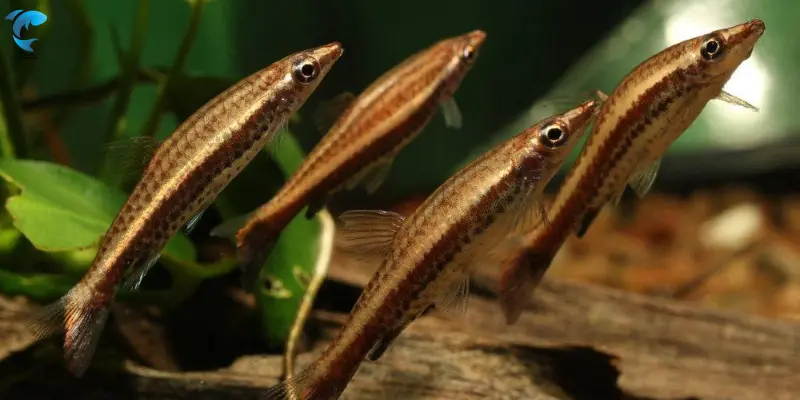
Appearance
These pencil-shaped fish reach about 2 inches (5 cm) and have a distinctive head-up swimming position. They display horizontal stripes along their sides and reddish accents on their fins.
Care Requirements
- Tank Size: 20 gallons minimum
- Water Parameters: 73-82°F (23-28°C), pH 5.5-7.5, soft to medium hardness
- Social Structure: Require groups of at least 6
- Special Considerations: Need low-flow areas and floating plants
- Diet: Tiny surface-dwelling foods such as fruit flies and crushed flakes
Why They’re Great: Their unique angled swimming style and habit of drifting along the surface, looking for tiny food particles, make them fascinating. In 2025, new breeding techniques made these once-delicate fish more robust for community tanks at Aquarium Co-op.
4. Clown Killifish (Epiplatys annulatus)
Also known as Rocket Killifish or Banded Panchax, these colorful nanofish are perfect surface dwellers for smaller tanks.
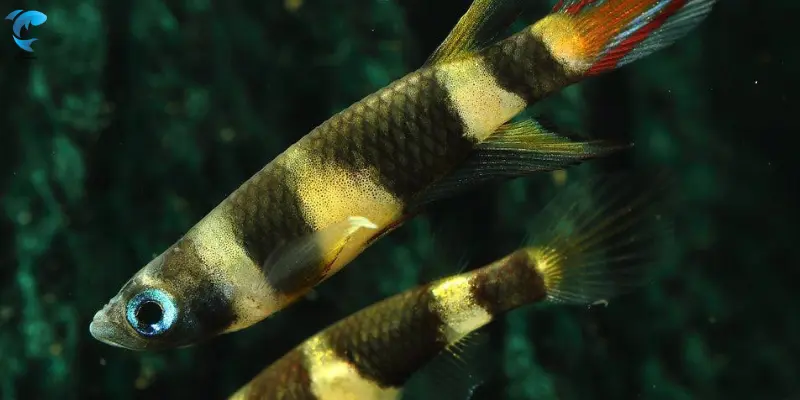
Appearance
The Clown Killifish, or the Rocket Killifish or Banded Panchax, is a colorful nano-fish perfect for smaller tanks. These fish, with their striking vertical black bands on a golden body and the spectacular red, yellow, and blue coloration of the males, add a vibrant pop to your aquarium.
Care Requirements
- Tank Size: Can thrive in tanks as small as 5 gallons
- Water Parameters: 67-80°F (19-26°C), pH 6.0-7.0, soft to medium hardness
- Social Structure: Keep in groups with a ratio of 1 male to 2-3 females
- Special Considerations: Need tight-fitting lids and floating plants
- Diet: Tiny floating foods, including Easy Fry Food, crushed flakes, and freeze-dried daphnia
Why They’re Great: Their vibrant colors and tendency to stay in the upper third of the tank make them excellent nanofish for planted aquariums. For 2025, they’ve become particularly popular for desk-sized tanks and minimalist setups, Aquarium Co-op.
5. Threadfin Rainbowfish (Iriatherina werneri)
Threadfin Rainbowfish are delicate, elegant surface swimmers with stunning finnage.
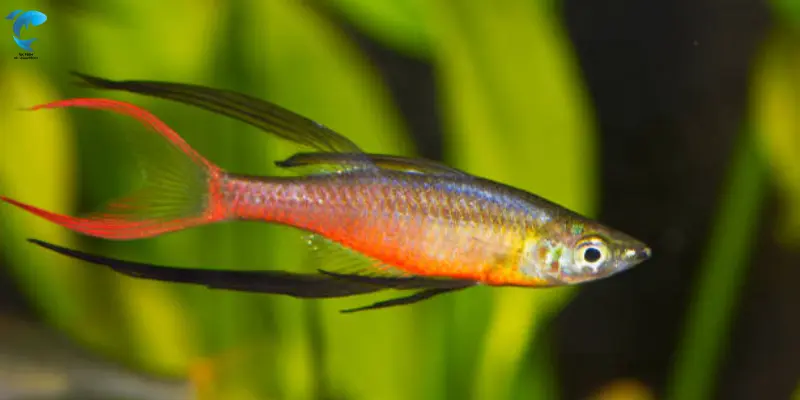
Appearance
These slender fish reach about 2 inches (5 cm) and are known for their elongated, thread-like fin extensions. Males display spectacular finnage with flowing extensions and iridescent colors.
Care Requirements
- Tank Size: 15-20 gallons minimum
- Water Parameters: 75-82°F (24-28°C), pH 6.5-7.5
- Social Structure: Keep in groups of at least 6
- Special Considerations: Peaceful fish that need gentle water flow
- Diet: Small live foods and high-quality flake food
Why They’re Great: Threadfin Rainbowfish are peaceful, top-swimming fish that display beautiful iridescent colors when kept in optimal conditions. Their delicate, flowing fins create an elegant display at the top of the tank. In 2025, new breeding variations with enhanced fin development have made them even more attractive, MSN.
6. African Butterflyfish (Pantodon buchholzi)
The African Butterflyfish is a fascinating oddball species with a unique appearance and surface-dwelling habits.
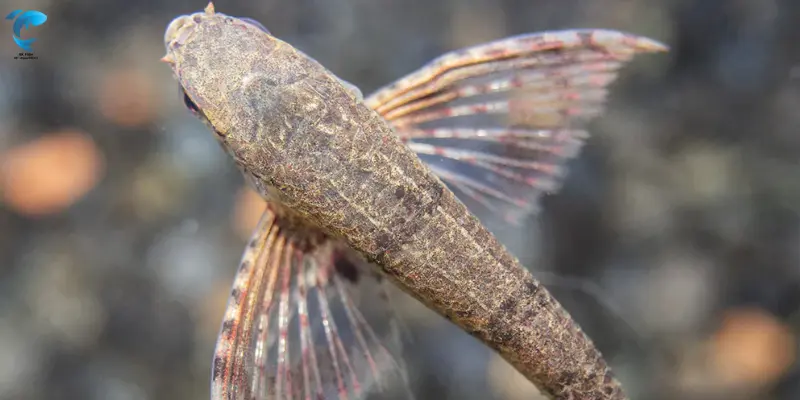
Appearance
They grow to about 4-5 inches (10-13 cm) and have a flattened body with large, wing-like pectoral fins, mottled brown coloration, and upward-facing mouths.
Care Requirements
- Tank Size: Minimum 30 gallons with a large surface area
- Water Parameters: 75-86°F (24-30°C), pH 6.0-7.5, soft to medium hardness
- Social Structure: Solitary or with very peaceful tank mates
- Special Considerations: Requires floating plants for cover and a secure lid
- Diet: Surface-feeding carnivore that enjoys insects, small fish, and prepared foods
Why They’re Great: Their unusual appearance and predatory feeding habits make them a fascinating centerpiece fish. In 2025, an improved understanding of their dietary needs will make them easier to maintain in home aquariums, Aquarium Co-op.
7. Common Danios (Danio species)
Common Danios, including Zebra, Leopard, and Blue varieties, are energetic top-to-middle swimmers that bring constant movement to the upper tank regions.

Appearance
These small, streamlined fish grow to about 2 inches (5 cm) and feature distinctive horizontal stripes or spots depending on the variant.
Care Requirements
- Tank Size: 20 gallons for a proper school
- Water Parameters: 64-74°F (18-23°C), pH 6.5-7.5, adaptable to various water conditions
- Social Structure: School of 6 or more
- Special Considerations: Prefer cooler water and an active swimming space
- Diet: Omnivorous and opportunistic feeders
Why They’re Great: Danios are hardy, active fish that constantly patrol the upper areas of the tank, adding dynamic movement. Their cooler water preference makes them ideal for unheated setups, which became more popular in 2025 as energy-efficient options for OurAquariumLife.
8. Dwarf Gourami (Trichogaster lalius)
Dwarf Gouramis are colorful labyrinth fish that frequently visit the surface to breathe atmospheric air.
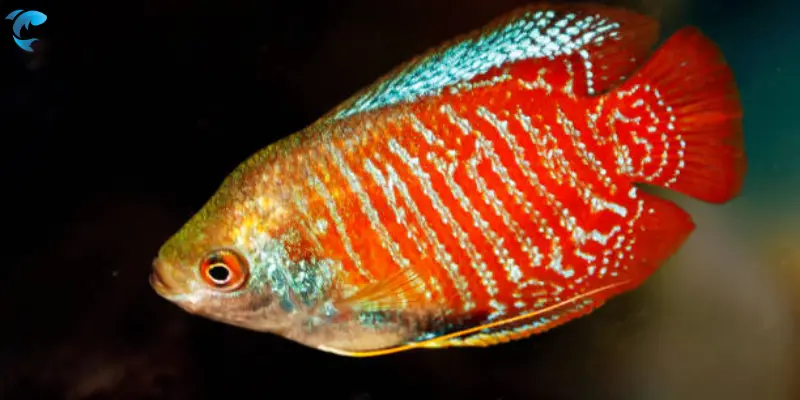
Appearance
Growing to about 2-3 inches (5-7.6 cm), they display vibrant colors with iridescent blue or red bodies adorned with vertical orange or red stripes.
Care Requirements
- Tank Size: 10 gallons minimum, 20 gallons recommended
- Water Parameters: 72-82°F (22-28°C), pH 6.0-7.5
- Social Structure: Can be kept singly or in pairs
- Special Considerations: Need easy access to the surface for air-breathing
- Diet: Omnivorous, accepting flake, freeze-dried, and live foods
Why They’re Great: As labyrinth fish, Dwarf Gouramis regularly visit the surface to breathe atmospheric air through their specialized labyrinth organ, making them natural top-dwellers. Their vibrant colors and relatively peaceful nature make them popular choices for community tanks in 2025, particularly the newer, healthier strains developed to address previous disease concerns, Aquarium Co-op.
9. Golden Wonder Killifish (Aplocheilus lineatus)
The Golden Wonder Killifish is a larger, more robust surface dweller with a predatory nature.
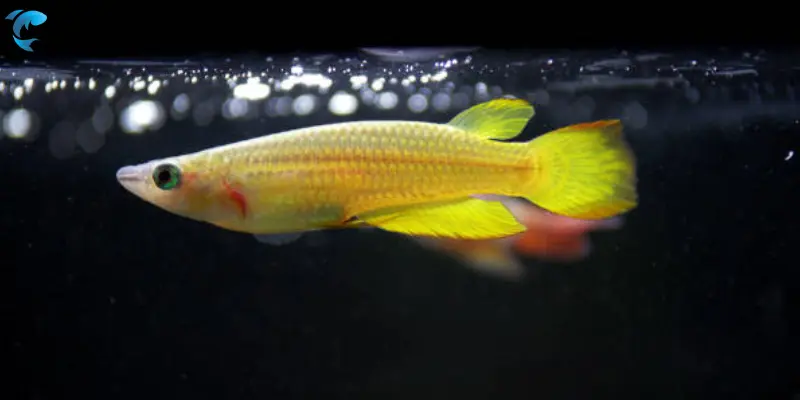
Appearance
They grow to 3-4 inches (7.6-10 cm) and have a long, torpedo-shaped body with a goldish-yellow coloration and iridescent scales.
Care Requirements
- Tank Size: 20 gallons minimum
- Water Parameters: 72-78°F (22-26°C), pH 6.5-7.5
- Social Structure: Somewhat territorial; keep one male with several females
- Special Considerations: Need a secure lid as they are excellent jumpers
- Diet: Carnivorous, enjoying live foods, frozen foods, and large pellets
Why They’re Great: Their striking gold coloration and impressive size make them stand out in the upper water column. They’re also efficient predators of pest insects that fall into the tank. In 2025, they’ve gained popularity for their effectiveness in controlling pest populations like hydra and planaria in display tanks Aquarium Co-op.
10. Halfbeaks (Nomorhamphus spp. and Dermogenys spp.)
Halfbeaks are unique live-bearing fish with distinctive extended lower jaws that make them perfect surface dwellers.
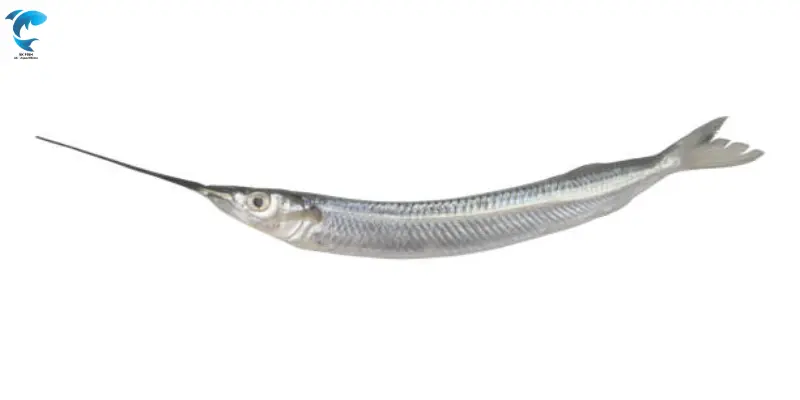
Appearance
Reaching 2-3 inches (5-7.6 cm), they’re instantly recognizable by their long, beak-like lower jaw that extends far past the upper jaw.
Care Requirements
- Tank Size: 20 gallons minimum with a large surface area
- Water Parameters: 72-82°F (22-28°C), pH 7.0-8.0
- Social Structure: Keep in groups with more females than males
- Special Considerations: Need floating plants and a secure lid
- Diet: Surface-feeding insectivore that enjoys fruit flies, small crickets, and floating pellets
Why They’re Great: Their unusual appearance and surface-skimming behavior fascinate them. Recent breeding advances in 2025 have made species like the Celebes Halfbeak (Nomorhamphus liemi) more readily available to hobbyists through Aquarium Co-op.
Why Choose Top-Dwelling Fish?
Adding surface-dwelling fish to your aquarium brings several benefits:
- Visual Balance: They activate the upper third of the tank, creating a more complete and balanced aquascape.
- Natural Behavior: Each species has evolved adaptations specifically for surface living, like upward-facing mouths for feeding on floating food and insects.
- Specialized Feeding Niches: Top-dwellers efficiently consume floating foods that mid and bottom-dwellers might otherwise ignore.
- Biological Diversity: A complete ecosystem includes organisms at all levels, creating a more natural environment.
- Pest Control: Many surface-dwelling species consume insects that fall into the tank, helping to maintain tank cleanliness.
General Care Tips for Top-Dwelling Species
To ensure the health and happiness of your top-dwelling fish, consider these care guidelines:
- Secure Lids: Many surface dwellers are accomplished jumpers, particularly hatchetfish and killifish. Always use a tight-fitting lid with no gaps.
- Floating Plants: Provide floating plants like frogbit, water lettuce, or Salvinia to offer shelter, spawning sites, and natural shade.
- Surface Feeding: Feed appropriate floating foods that won’t sink before your surface dwellers can consume them.
- Water Flow: Many top-dwelling species prefer gentle water movement at the surface. Adjust filter outputs accordingly.
- Tank Depth: While not essential, tanks with a larger surface area relative to their volume (like “long” or “breeder” style tanks) often work better for surface species.
- Water Quality: Maintain excellent water quality with regular water changes, as the surface can accumulate films and debris.
Trending in 2025: What’s New with Surface Dwellers?
The aquarium hobby has seen several developments for top-dwelling species in 2025:
- Improved Breeding Success: Many once-rare surface dwellers like Pencilfish and particular Killifish species are now commercially bred, making them more affordable and adaptable to aquarium conditions.
- Disease-Resistant Strains: New, healthier strains of traditional surface dwellers like Gouramis have been developed to address historical disease concerns.
- Nano Surface Specialists: With the continued popularity of nano tanks, there has been increased focus on smaller surface-dwelling species that thrive in limited spaces.
- Sustainable Collection: For species still primarily wild-caught, like some Hatchetfish varieties, more sustainable collection methods are being implemented to reduce mortality rates and environmental impact.
- Specialized Surface Foods: New floating food formulations specifically designed for the nutritional needs of surface-dwelling species have entered the market.
Conclusion
Incorporating top-dwelling fish into your aquarium completes the visual appeal of your underwater landscape and creates a more diverse and naturalistic ecosystem. From the elegant Threadfin Rainbowfish to the oddball African Butterflyfish, there’s a surface dweller to complement every aquarium style in 2025. By understanding their specific needs and providing appropriate care, you can enjoy the dynamic movement and interesting behaviors these special fish bring to the upper regions of your tank.
Whether setting up a new tank or looking to fill that space at the top of an existing aquarium, these ten species offer excellent options for bringing life to the surface.
FAQ: Fish That Stay at the Top of the Tank
Fish at the top of the tank typically do so for a few reasons. Many species are naturally surface dwellers, meaning they prefer to inhabit the upper layers of water. Fish like bettas, goldfish, and guppies are examples of surface feeders. They may also stay at the top to access oxygen from the water’s surface, especially if oxygen levels are lower deeper in the tank. Additionally, some fish may exhibit behavior due to water temperature, hunger, or stress. If your fish stays at the top, it’s crucial to observe if it’s eating well, moving normally, and showing no signs of illness.
Not necessarily. While fish at the top of the tank can sometimes indicate health issues like poor water quality or low oxygen levels, many species naturally live in the upper layers of water. If the fish is otherwise active, eating well, and behaving normally, it’s likely just exhibiting natural behavior. However, if the fish seems lethargic, has trouble swimming, or is constantly gasping for air, it’s essential to check the water parameters (like oxygen, ammonia, nitrite, and pH levels) and consult a veterinarian if necessary.
If you have fish that stay at the top of the tank and it seems unusual for the species, or if the behavior is associated with distress, here are a few things you can try:
- Check the water quality: Ensure the water is clean and properly filtered, with stable temperature, pH, and oxygen levels.
- Increase aeration: Use an air pump or stone to increase water movement and oxygenation.
- Adjust tank setup: Ensure enough space in the tank for the fish to move freely and no obstructions causing stress.
- Monitor for illness: Look for signs of illness, such as changes in appearance, abnormal swimming, or changes in appetite, and address any issues promptly.
Providing a stable environment and regular tank maintenance should help resolve any issues.
Several fish species stay at the top of the tank naturally. These include:
- Bettas are often found near the surface as they breathe air from the water.
- Guppies: A popular surface feeder species that often hangs near the top of the tank.
- Goldfish: Depending on the setup, some goldfish prefer to swim near the top.
- Tetras: Many species of tetras are known to stay near the surface, especially during feeding times.
- Angelfish: These fish often swim in the upper-middle areas of the tank.
It’s essential to research each species’ natural habitat to understand its preferred swimming area and behavior.
If your fish is not a surface-dwelling species but is staying at the top of the tank, here are a few things to consider:
- Improve water quality: Fish may swim at the top if the oxygen level is low or the water is polluted. Regular water changes and checking the filtration system can help.
- Check temperature and pH: Ensure the tank’s temperature is ideal for the species, and the pH level is balanced.
- Add aeration: Increasing water movement with an air pump or a surface agitator can help circulate oxygen.
- Consider stress factors: Overcrowding, aggressive tankmates, or inadequate tank setup can lead to stress, causing fish to seek the top of the tank.
Addressing these factors can help encourage more natural behavior from your fish.
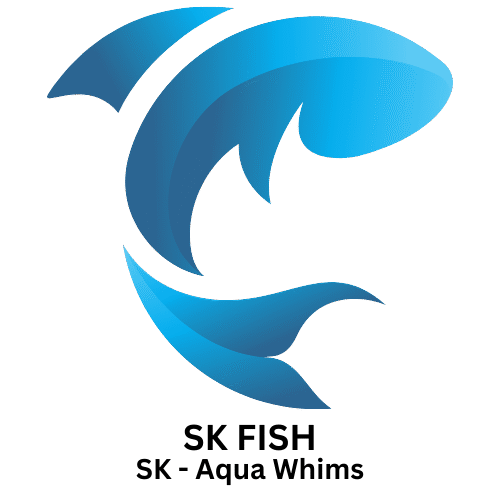
SK Fish is your trusted source for practical fish care tips and delicious seafood recipes. Our team is dedicated to providing reliable, well-researched content for fishing enthusiasts and home cooks alike.

- Be Respectful
- Stay Relevant
- Stay Positive
- True Feedback
- Encourage Discussion
- Avoid Spamming
- No Fake News
- Don't Copy-Paste
- No Personal Attacks



- Be Respectful
- Stay Relevant
- Stay Positive
- True Feedback
- Encourage Discussion
- Avoid Spamming
- No Fake News
- Don't Copy-Paste
- No Personal Attacks



